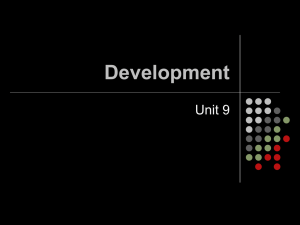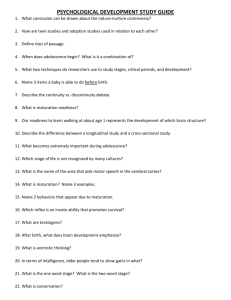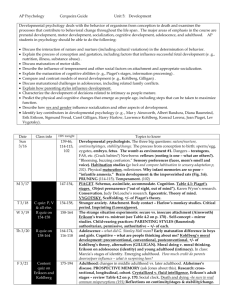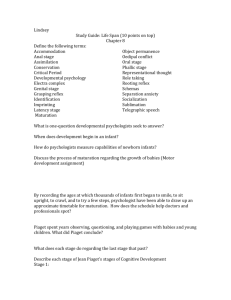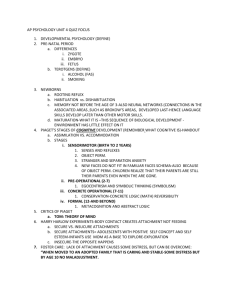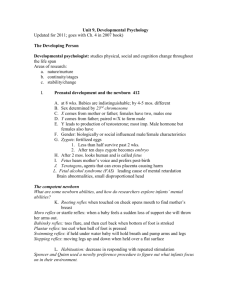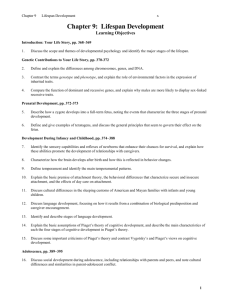Unit Four (Developmental Psychology) Notes
advertisement
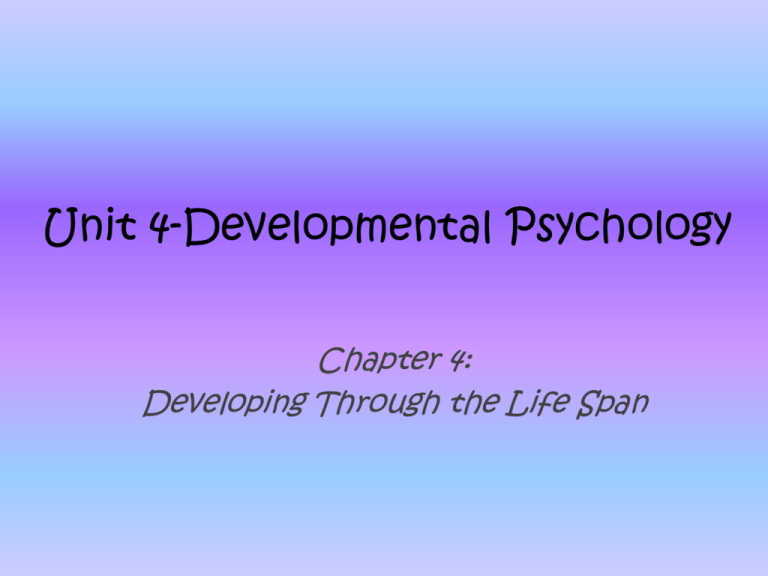
Unit 4-Developmental Psychology Chapter 4: Developing Through the Life Span What is developmental psychology? • developmental psychology- a branch of psychology that studies physical, cognitive, and social change throughout the life span Princess Diana: A Case Study in Development • development- the sequence of age-related changes that occur as a person progresses from conception to death Developmental Psychology’s Three Major Issues: 1. nature/nurture How do genetic influences and our experiences influence development? 2. continuity/stages Is development gradual or does it go through sequences? 3. stability/change Do our early personality traits stay the same or do we change as we age? Prenatal Development and the Newborn ―Give me a dozen healthy infants, well-formed, and my own specified world to bring them up in and I’ll guarantee to take any one at random and train him to become any type of specialist I might select—doctor, lawyer, artist, merchant-chief and yes, even, beggarman and thief, regardless of his talents, penchants, tendencies, abilities, vocations, and race of his ancestors.‖ ~John Watson (Behaviorism, 1925) What happens at conception? • sperm releases digestive enzymes to eat away the egg’s protective coating and then enters • the surface of the egg blocks out other sperm and helps to pull the one successful sperm inside • within half a day, the nuclei of each have fused Three Phases of the Prenatal Period • Germinal Stage – zygote- fertilized egg; conception to 2 weeks; cells multiply and then differentiate • Embryonic Stage – embryo- 2 weeks to 8 weeks; organs begin to form and function; heart begins to beat • Fetal Stage – fetus- 9 weeks to birth – age of viability- age at which a baby can survive in the event of premature birth Environmental Factors on Prenatal Development • maternal nutrition • maternal drug use • maternal illness • prenatal health care What innate abilities do newborns have? •abilities that enable survival (rooting reflex) •habituation-a decrease in responding with repeated stimulation PHYSICAL DEVELOPMENT OF AN INFANT Physical Development of an Infant The Brain: • The day you were born, you had the most brain cells you will ever have, but your nervous system was very immature. • maturation- biological growth processes that enable orderly changes in behavior, relatively uninfluenced by experience Motor Development: • as muscles and nervous system mature, more complicated skills emerge • for the most part, the sequence of motor development is universal • cephalocaudel trend and proximodistal trend Landmarks in Motor Development Memory: • we rarely remember anything from our first 3 years (infantile amnesia) • we organize memories differently after age 3-4 COGNITIVE DEVELOPMENT OF AN INFANT Jean Piaget (1896-1980) The Work of Jean Piaget ―Assessing the impact of Piaget on developmental psychology is like assessing the impact of Shakespeare in English literature.‖ ~Harry Beilin (1992), developmental psychologist • A child’s mind develops through a series of stages. This progression is driven by our attempts to make sense of our experiences. • schema-concept or framework that organizes and interprets information ―The Devil’s Tuning Fork‖— an impossible object How do we use these schemas? • assimilation- interpreting one’s new experience in terms of one’s existing schemas (or current understanding) This is our dog Lucky. Lucky has four legs and a tail! Hmmm…what’s this? It has four legs and a tail, like Lucky…it must be a dog! • accommodation- adapting current understandings to incorporate new information That can’t be right. They have different noses. This must be something else! • cognition-all the mental activities associated with thinking, knowing, remembering, and communicating Sensorimotor Stage (birth to age 2) • babies take in the world through sensory and motor interactions with objects • object permanence- awareness that things continue to exist even when not perceived Preoperational Stage (age 2 to age 6 or 7) • child learns to use language, but does not yet comprehend the mental operations of concrete logic • children lack the concept of conservation- principle that quantity remains the same despite changes in shape Piaget’s Conservation Task • egocentrism- preoperational child’s difficulty taking some else’s view – animism- belief that all things are living • theory of mind- people’s ideas about their own and others’ mental states— about their feelings, perceptions, and thoughts and the behavior these might predict Two Other Flaws in Preoperational Thinking • centration-tendency to focus on one feature of a problem, ignoring other aspects • irreversibility- the inability to envision reversing an action Concrete Operational Stage (age 6 or 7 to age 11) • children gain mental operations that allow them to think logically about concrete events Mr. Jones went into a restaurant and ordered a whole pizza for his dinner. When the waiter asked if he wanted it cut into 6 or 8 pieces, Mr. Jones said, ―Oh you’d better make it 6, I could never eat 8 pieces!‖ • reversibility- permits a child to mentally undo an action • decentration- allows a child to focus on more than one feature of a problem simultaneously Give a preoperational child seven carnations and three daisies. Tell the child the names for the two types and ask the child to sort them. Then ask if there are more carnations or more daisies. Now ask if there are more carnations or more flowers. The Water-Level Task Where does the water line belong in figure B? Figure A Figure B Formal Operational Stage (begins at age 12) • people begin to think logically about abstract concepts; reasoning expands from purely concrete to include abstract thinking Concept Check Which stage of Piaget’s theory is represented by each? a. sensorimotor b. preoperational c. concrete operational d. formal operational 1. Upon seeing a glass lying on its side, Sammy says, ―Look, the glass is tired. It’s taking a nap.‖ 2. Maria is told that a farmer has 9 cows and 6 horses. The teacher asks, ―Does the farmer have more cows or more animals? ― Maria answers, ―More animals.‖ 3. Alice is playing in the living room with a small red ball. The ball rolls under the sofa. She stares for a moment at the place where the ball vanished and then turns her attention to a top truck sitting in front of her. What can we say about Piaget’s theories today? • Human cognition does seem to follow the sequences proposed by Piaget. • But, today we see development as more continuous than Piaget did. SOCIAL DEVELOPMENT OF AN INFANT Social Development • infants develop intense bonds with their caregivers – stranger anxiety The brain, mind, and social-emotional behavior develop together! Harry Harlow and Attachment attachment- emotional tie with another person; survival impulse causing infants to keep close to caregivers critical period- optimal period shortly after birth when an organism’s exposure to certain stimuli or experiences produces proper development Familiarity & Imprinting John Bowlby, Mary Ainsworth and Attachment John Bowlby a biological basis for attachment Mary Ainsworth three categories: 1. secure 2.anxious-ambivalent 3. avoidant secure vs. insecure attachment • sensitive, responsive mothers = infants with secure attachment • insensitive, unresponsive mothers = infants with insecure attachment BUT—is this because of parenting or the result of genetics (temperament)? What effect does neglect, abuse or disruption have on attachment? ―What is learned in the cradle, lasts to the grave.‖ ~French proverb major social achievement of infancy is attachment major social achievement of childhood is a positive sense of self self-concept • sense of a child’s own identity and personal worth; most children develop by age 12 • children with a positive self-concept are more confident, independent, optimistic, assertive, sociable 1 Neglectful 1 Permissive Parenting Styles Authoritarian Authoritative 7 7 parenting styles Four Parenting Styles 1. permissive- submit to children’s desires; make few demands; use little punishment 2. authoritarian- impose rules and expect obedience 3. authoritative-demanding and responsive 4. neglectful- provides neither warmth nor control Children with the highest self-esteem, selfreliance and social competence, usually have authoritative parents. BUT—correlation does not equal causation! ~maybe children’s traits influence parenting ~maybe a third factor is at work (i.e. genes) Today’s Target: We will understand Vygotsky’s contributions to infant and childhood development and begin to look at adolescent cognitive development. Lev Vygotsky (1896-1934) sociocultural perspective • whereas Piaget emphasized importance of physical environment, Vygotsky emphasized interaction with the social environment A difference in Piaget and Vygotsky’s interpretations of development… Piaget told this story about a friend: When he was a small child, he was counting pebbles one day; he lined them up in a row, counted them from left to right, and got to ten. Then, just for fun, he counted them from right to left to see what number he would get, and was astonished that he got ten again. He put the pebbles in a circle and counted them, and once again there were ten. And no matter how he put the pebbles down, when he counted them, the number came to ten. He discovered there what is known in mathematics as commutativity, that is, the sum is independent of the order. language • language is the foundation for development of higher thought • private speech- preschool age children (age 4-6) often talk aloud • as they get older, this transitions to inner speech—the normal internal dialogue we all have zone of proximal development (ZPD) • ZPD-gap between what a learner can do alone and what they can do with the guidance of others (more skilled) • scaffolding-assistance provided is adjusted as learning progresses Development is lifelong. Adolescence life between childhood and adulthood •begins with physical changes of sexual maturity and ends with social achievement of independent adult status •―storm and stress‖ Physical Changes in Adolescence • puberty- period of sexual maturation; person becomes capable of reproduction • brain development is ongoing throughout adolescence Cognitive Development in Adolescence • begin to reason and think about thinking • early teens reasoning is often self-focused • begin to develop character and learn right from wrong ―The Heinz Dilemma‖ In Europe, a woman was near death from cancer. One drug might save her, a form of radium that a druggist in the same town had recently discovered. The druggist was charging $2,000, ten times what the drug cost him to make. The sick woman’s husband, Heinz, went to everyone he knew to borrow the money, but he could only get together about half of what it cost. He told the druggist that his wife was dying and asked him to sell it cheaper or let him pay later. But the druggist said, ―No.‖ The husband got desperate and broke into the man’s store to steal the drug for his wife (Kohlberg, 1969, p.379). ―Should the husband have done that? Why?‖ A More Modern Tale Dave had left his mother in the midst of a coughing fit. She was out of medication and he knew it. Unfortunately, the rent and the heating bill had depleted the family’s financial resources. On the way to school, Dave stops at the campus bookstore just to ―catch the newspaper headlines.‖ As he passes through the check-out counter, he notices that the cash register has been left open and is unattended. Quickly he reaches over, takes four 10 dollar bills from the drawer and stuffs them in his pocket. ―This place has been ripping off students for so long they can afford it‖ he mutters to himself. Next stop…the campus pharmacy. Did Dave do something wrong? Why or why not? Developing Morality Lawrence Kohlberg (1927-1987) Three Basic Levels of Moral Thinking: 1. preconventional morality- before age 9; self-interest; obey to avoid punishment or gain concrete rewards 2. conventional morality- early adolescence; caring for others; upholding laws and rules because that is what you should do 3. postconventional morality- not everyone gets to this level; involves working out a personal code of ethics and morals and rules become more flexible based on that code Right and wrong is determined by what is rewarded. Right and wrong is determined by close others’ approval or disapproval. Stage 4. Stage 3 Right and wrong is determined by society’s rules, and laws, which should be obeyed rigidly. Right and wrong is determined by society’s rules, which are viewed as fallible rather than absolute. Stage 6 Stage 5 Right and wrong is determined by what is punished. Stage 2 Stage 1 Punishment orientation Naïve reward orientation Good boy/ good girl orientation Authority orientation Social contract orientation Individual principles and conscience orientation Right and wrong is determined by abstract ethical principles that emphasize equity and justice. A Midwest biologist has conducted numerous studies demonstrating that simple organisms such as worms and paramecia can learn through conditioning. It occurs to her that perhaps she could condition fertilized human ova, to provide a dramatic demonstration that abortions destroy adaptable, living human organisms. This possibility appeals to her, as she is ardently opposed to abortion. However, there is no way to conduct the necessary research on human ova without sacrificing the lives of potential human beings. She desperately wants to conduct the research, but obviously, the sacrifice of human ova is fundamentally incompatible with her belief in the sanctity of human life. What should she do? Why? Which of the following statements best illustrates the three levels of moral reasoning? a=preconventional b=conventional c=postconventional 1. She should do the research. Although it’s wrong to kill, there’s a greater good that can be realized through the research. 2. She shouldn’t do the research because people will think that she’s a hypocrite and condemn her. 3. She should do the research because she may become rich and famous as a result. • moral judgments are made quickly and automatically • morality also includes doing the right thing Carol Gilligan (born 1936) • In a Different Voice: Psychological Theory and Women’s Development (1982) • Criticized Kohlberg’s work 1. Kohlberg only studied privileged, white men and boys, therefore his work is biased. 2. In his theory, the male view of individual rights and rules was seen as a higher stage than women’s point of view development. Social Development Erik Erikson (1902-1994) • each life stage has a ―psychosocial task‖ (a crisis that needs resolution) • your personality is determined by how you deal with each Erikson’s Stages of Psychosocial Development and the New Environments for Each Stage 1 (infancy) Stage 2 (1-2 years) Stage 3 (3-5 years) Stage 4 (6 years – puberty) • Trust vs. Mistrust • Is my world predictable and supportive? • Autonomy vs. Shame & Doubt • Can I do things myself or must I always rely on others? • Initiative vs. Guilt • Am I good or am I bad? • Industry vs. Inferiority • Am I competent or am I worthless? Stage 5 (adolescence) Stage 6 (young adulthood) Stage 7 (middle adulthood) Stage 8 (late adulthood) • Identity vs. Confusion • Who am I and where am I going? • Intimacy vs. Isolation • Shall I share my life with another or live alone? • Generativity vs. Self-absorption • Will I produce something of real value? • Integrity vs. Despair • Have I lived a full life? • identity- one’s sense of self • How does one form their identity? • part of adolescence is to achieve a purpose Once you know who you are, you are ready for close relationships. How do we evaluate Erikson’s theory? • accounts for continuity AND transition (+) • depends heavily on case studies (-) • provides ―ideal‖ descriptions of ―typical‖ development (-) Influence of Parents and Peers • adolescents begin to separate themselves from their parents and look more towards their peers Emerging Adulthood (age 18-mid 20s) Adulthood ―I am still learning.‖ Michaelangelo (1560) at age 85 • development at this stage is harder to generalize about than our younger years Physical Changes in Middle Adulthood • physical ability • resulting psychological changes • men vs. women Physical Changes in Late Adulthood • life expectancy 1950-49 years 2004-67 years some developed countries-80+ years • our bodies wear out eventually! • our neural processing slows; brain-weight decreases ―use it or lose it‖ Cognitive Development in Adulthood • Do adult cognitive abilities parallel the gradual and accelerating decline of physical abilities? • Does intelligence increase or decrease with age? • crystallized intelligence- accumulated knowledge and verbal skills; usually increases with age • fluid intelligence- ability to reason speedily and abstractly; usually decreases during late adulthood Social Development in Adulthood • life events indicate transitions to new life stages, whenever they occur • social clock- cultural prescription of the ―right time‖ for life events; varies between cultures and time eras In 1965… Best age for a man to marry Best age for a woman to marry Best age to finish school and go to work When most men should be settled on a career When most men hold their top jobs When most people should become grandparents When most people should be ready to retire 20-25 19-24 20-22 24-26 45-50 45-50 60-65 Love and work dominate adulthood Across the Lifespan… • early adulthood to midlife brings a strengthening sense of identity, confidence, and self-esteem Death and Dying • usually most difficult separation is from a spouse • there are no real stages of grief or a ―normal‖ reaction to death • grief is more severe when death is sudden and unexpected

